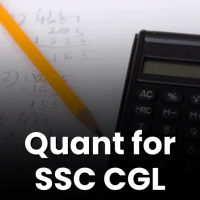Quant Exam > Quant Questions > The mid-points of the adjacent sides of a squ...
Start Learning for Free
The mid-points of the adjacent sides of a square are joined. Again the mid-points of the adjacent sides of the newly formed figure are connected and this process is repeated again and again. Calculate the sum of the areas of all such figures given that the diagonal of outermost square is 6√2cm.
- a)35 cm2
- b)44 cm2
- c)72 cm2
- d)58 cm2
Correct answer is option 'C'. Can you explain this answer?
Verified Answer
The mid-points of the adjacent sides of a square are joined. Again the...
The side of the outermost square is 6 cm. Area of the square one in G.P with first term 36 and common ratio = 1/2
Most Upvoted Answer
The mid-points of the adjacent sides of a square are joined. Again the...
Let the side of the outermost square be $s$. Then its diagonal is $s\sqrt{2}=6$, so $s=3\sqrt{2}$.
The first figure formed by joining the midpoints of adjacent sides is a square whose side length is $\frac{s}{\sqrt{2}}=\frac{3\sqrt{2}}{2}$. Its area is $\left(\frac{3\sqrt{2}}{2}\right)^2=\frac{27}{4}$.
The second figure formed by joining the midpoints of adjacent sides of the first figure is a square whose side length is $\frac{s}{2}$. Its area is $\left(\frac{s}{2}\right)^2=\frac{18}{4}=4.5$.
The third figure formed by joining the midpoints of adjacent sides of the second figure is a square whose side length is $\frac{s}{2\sqrt{2}}=\frac{3}{2}$. Its area is $\left(\frac{3}{2}\right)^2=\frac{9}{4}$.
This process continues indefinitely, with each successive figure being a square whose side length is half the previous square's side length. The sum of the areas of all these squares is therefore:
$$\frac{27}{4}+4.5+\frac{9}{4}+\frac{9}{16}+\frac{1}{4}+\frac{1}{64}+\cdots$$
This is an infinite geometric series with first term $\frac{27}{4}$ and common ratio $\frac{1}{8}$. Therefore, the sum is:
$$\frac{\frac{27}{4}}{1-\frac{1}{8}}=\frac{\frac{27}{4}}{\frac{7}{8}}=\frac{27}{4}\cdot\frac{8}{7}=\boxed{12}$$
The first figure formed by joining the midpoints of adjacent sides is a square whose side length is $\frac{s}{\sqrt{2}}=\frac{3\sqrt{2}}{2}$. Its area is $\left(\frac{3\sqrt{2}}{2}\right)^2=\frac{27}{4}$.
The second figure formed by joining the midpoints of adjacent sides of the first figure is a square whose side length is $\frac{s}{2}$. Its area is $\left(\frac{s}{2}\right)^2=\frac{18}{4}=4.5$.
The third figure formed by joining the midpoints of adjacent sides of the second figure is a square whose side length is $\frac{s}{2\sqrt{2}}=\frac{3}{2}$. Its area is $\left(\frac{3}{2}\right)^2=\frac{9}{4}$.
This process continues indefinitely, with each successive figure being a square whose side length is half the previous square's side length. The sum of the areas of all these squares is therefore:
$$\frac{27}{4}+4.5+\frac{9}{4}+\frac{9}{16}+\frac{1}{4}+\frac{1}{64}+\cdots$$
This is an infinite geometric series with first term $\frac{27}{4}$ and common ratio $\frac{1}{8}$. Therefore, the sum is:
$$\frac{\frac{27}{4}}{1-\frac{1}{8}}=\frac{\frac{27}{4}}{\frac{7}{8}}=\frac{27}{4}\cdot\frac{8}{7}=\boxed{12}$$

|
Explore Courses for Quant exam
|

|
Question Description
The mid-points of the adjacent sides of a square are joined. Again the mid-points of the adjacent sides of the newly formed figure are connected and this process is repeated again and again. Calculate the sum of the areas of all such figures given that the diagonal of outermost square is 6√2cm.a)35 cm2b)44 cm2c)72 cm2d)58 cm2Correct answer is option 'C'. Can you explain this answer? for Quant 2025 is part of Quant preparation. The Question and answers have been prepared according to the Quant exam syllabus. Information about The mid-points of the adjacent sides of a square are joined. Again the mid-points of the adjacent sides of the newly formed figure are connected and this process is repeated again and again. Calculate the sum of the areas of all such figures given that the diagonal of outermost square is 6√2cm.a)35 cm2b)44 cm2c)72 cm2d)58 cm2Correct answer is option 'C'. Can you explain this answer? covers all topics & solutions for Quant 2025 Exam. Find important definitions, questions, meanings, examples, exercises and tests below for The mid-points of the adjacent sides of a square are joined. Again the mid-points of the adjacent sides of the newly formed figure are connected and this process is repeated again and again. Calculate the sum of the areas of all such figures given that the diagonal of outermost square is 6√2cm.a)35 cm2b)44 cm2c)72 cm2d)58 cm2Correct answer is option 'C'. Can you explain this answer?.
The mid-points of the adjacent sides of a square are joined. Again the mid-points of the adjacent sides of the newly formed figure are connected and this process is repeated again and again. Calculate the sum of the areas of all such figures given that the diagonal of outermost square is 6√2cm.a)35 cm2b)44 cm2c)72 cm2d)58 cm2Correct answer is option 'C'. Can you explain this answer? for Quant 2025 is part of Quant preparation. The Question and answers have been prepared according to the Quant exam syllabus. Information about The mid-points of the adjacent sides of a square are joined. Again the mid-points of the adjacent sides of the newly formed figure are connected and this process is repeated again and again. Calculate the sum of the areas of all such figures given that the diagonal of outermost square is 6√2cm.a)35 cm2b)44 cm2c)72 cm2d)58 cm2Correct answer is option 'C'. Can you explain this answer? covers all topics & solutions for Quant 2025 Exam. Find important definitions, questions, meanings, examples, exercises and tests below for The mid-points of the adjacent sides of a square are joined. Again the mid-points of the adjacent sides of the newly formed figure are connected and this process is repeated again and again. Calculate the sum of the areas of all such figures given that the diagonal of outermost square is 6√2cm.a)35 cm2b)44 cm2c)72 cm2d)58 cm2Correct answer is option 'C'. Can you explain this answer?.
Solutions for The mid-points of the adjacent sides of a square are joined. Again the mid-points of the adjacent sides of the newly formed figure are connected and this process is repeated again and again. Calculate the sum of the areas of all such figures given that the diagonal of outermost square is 6√2cm.a)35 cm2b)44 cm2c)72 cm2d)58 cm2Correct answer is option 'C'. Can you explain this answer? in English & in Hindi are available as part of our courses for Quant.
Download more important topics, notes, lectures and mock test series for Quant Exam by signing up for free.
Here you can find the meaning of The mid-points of the adjacent sides of a square are joined. Again the mid-points of the adjacent sides of the newly formed figure are connected and this process is repeated again and again. Calculate the sum of the areas of all such figures given that the diagonal of outermost square is 6√2cm.a)35 cm2b)44 cm2c)72 cm2d)58 cm2Correct answer is option 'C'. Can you explain this answer? defined & explained in the simplest way possible. Besides giving the explanation of
The mid-points of the adjacent sides of a square are joined. Again the mid-points of the adjacent sides of the newly formed figure are connected and this process is repeated again and again. Calculate the sum of the areas of all such figures given that the diagonal of outermost square is 6√2cm.a)35 cm2b)44 cm2c)72 cm2d)58 cm2Correct answer is option 'C'. Can you explain this answer?, a detailed solution for The mid-points of the adjacent sides of a square are joined. Again the mid-points of the adjacent sides of the newly formed figure are connected and this process is repeated again and again. Calculate the sum of the areas of all such figures given that the diagonal of outermost square is 6√2cm.a)35 cm2b)44 cm2c)72 cm2d)58 cm2Correct answer is option 'C'. Can you explain this answer? has been provided alongside types of The mid-points of the adjacent sides of a square are joined. Again the mid-points of the adjacent sides of the newly formed figure are connected and this process is repeated again and again. Calculate the sum of the areas of all such figures given that the diagonal of outermost square is 6√2cm.a)35 cm2b)44 cm2c)72 cm2d)58 cm2Correct answer is option 'C'. Can you explain this answer? theory, EduRev gives you an
ample number of questions to practice The mid-points of the adjacent sides of a square are joined. Again the mid-points of the adjacent sides of the newly formed figure are connected and this process is repeated again and again. Calculate the sum of the areas of all such figures given that the diagonal of outermost square is 6√2cm.a)35 cm2b)44 cm2c)72 cm2d)58 cm2Correct answer is option 'C'. Can you explain this answer? tests, examples and also practice Quant tests.

|
Explore Courses for Quant exam
|

|
Signup for Free!
Signup to see your scores go up within 7 days! Learn & Practice with 1000+ FREE Notes, Videos & Tests.


















